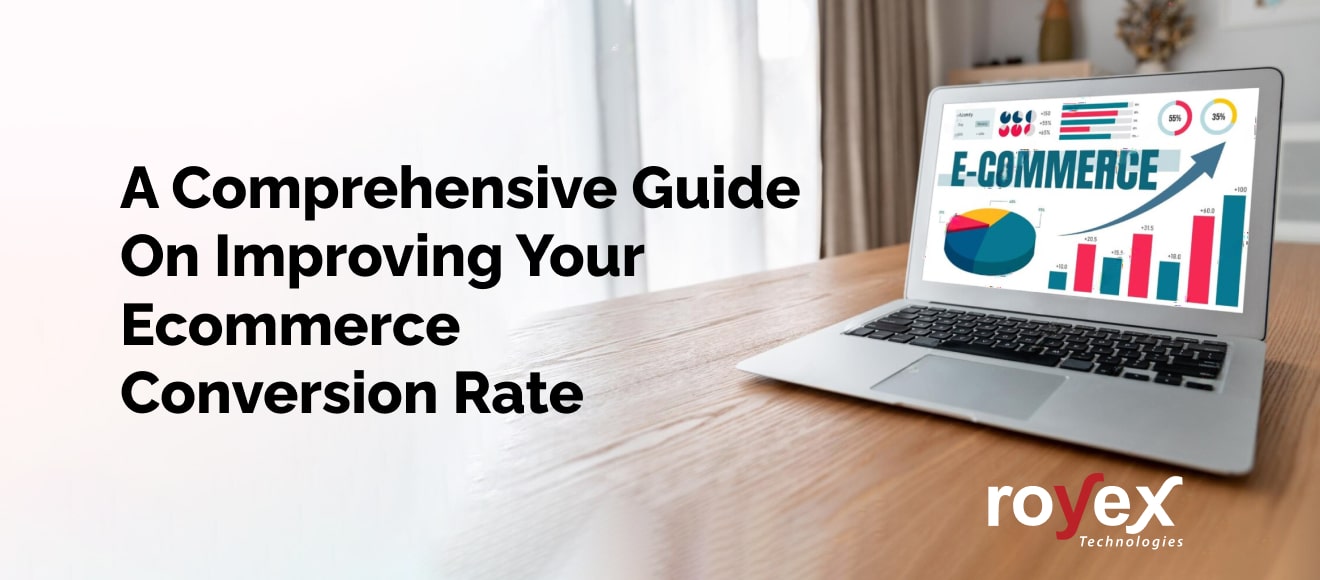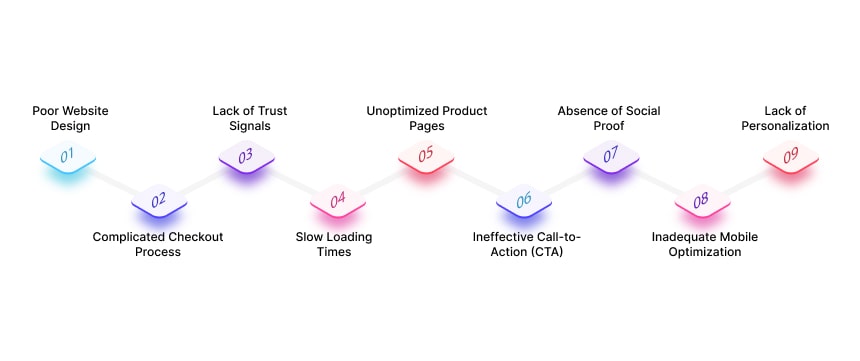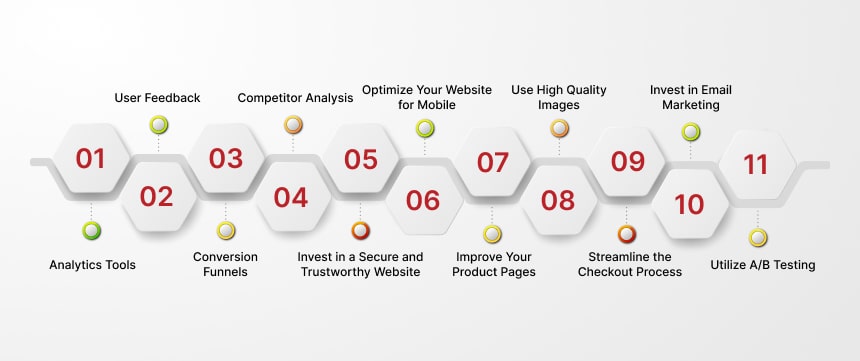
A Comprehensive Guide on Improving Your Ecommerce Conversion Rate
In the fiercely competitive world of e-commerce, attracting visitors to your online store is only half the battle. The success of any e-commerce business depends on its ability to convert those visitors into customers. Your e-commerce conversion rate is a critical metric that measures the percentage of visitors who make a purchase, sign up for a newsletter, or take another desired action on your site. A high conversion rate means more sales and higher profits, and a low conversion rate can be the death knell for an online business. That’s why it’s so important to understand the factors that affect conversion rates and how to optimize them.
In this article, we’ll discuss the fundamentals of e-commerce conversion rate optimization and provide actionable tips on how to improve your conversion rate.
We’ll start by exploring the different components of an e-commerce conversion rate: what it is, how it’s measured and why it’s important. We’ll then look at the common factors that can lead to a low conversion rate, and how to identify them. Finally, we’ll provide practical advice on how to increase conversion rates and maximize your online sales.
But before we get into the details, let’s take a step back and understand the concept of e-commerce conversion rate. What is it, and why does it matter?
The e-commerce conversion rate is a metric that quantifies the percentage of website visitors who take a desired action, typically making a purchase. It serves as a crucial performance indicator for online businesses, reflecting the effectiveness of a website in turning casual browsers into paying customers. A high conversion rate implies that a significant proportion of site visitors are successfully completing desired actions, contributing to increased revenue and business success. Monitoring and optimizing the e-commerce conversion rate is essential for businesses aiming to enhance user experience, streamline the purchase process, and ultimately boost their online sales.
Factors that can influence a conversion rate include product pricing, website design, customer service, payment methods, and ease of use. To improve conversion rates, online businesses should focus on providing a seamless user experience, optimizing pricing, and providing customer service that exceeds expectations. In essence, a higher conversion rate signifies not just website traffic, but the successful transformation of that traffic into tangible business outcomes. This metric matters for several reasons:
-
Revenue Generation: A higher conversion rate directly correlates with increased sales and revenue for the online business.
-
User Experience: Monitoring and improving conversion rates encourage businesses to enhance the overall user experience, making the purchasing journey seamless and enjoyable.
-
Marketing Effectiveness: It serves as a key indicator of the success of marketing efforts, helping businesses identify which strategies are resonating with their audience.
-
Optimization Focus: Businesses can use conversion rates to identify areas for improvement, refine website elements, and optimize marketing strategies to better meet customer needs.
Factors Leading to a Low Conversion Rate

-
Poor Website Design: A cluttered or confusing website layout can discourage visitors from making a purchase.
-
Complicated Checkout Process: Lengthy forms, excessive steps, or mandatory account creation can result in cart abandonment.
-
Lack of Trust Signals: Insufficient security measures, missing trust badges, or unclear privacy policies may erode customer trust.
-
Slow Loading Times: A sluggish website can frustrate users and drive them away before completing a transaction.
-
Unoptimized Product Pages: Inadequate product descriptions, low-quality images, or missing information can hinder purchase decisions.
-
Ineffective Call-to-Action (CTA): Weak or unclear CTAs may fail to prompt users to take the desired action, such as making a purchase.
-
Absence of Social Proof: Without customer reviews, testimonials, or ratings, potential buyers may lack the confidence to proceed with a purchase.
-
Inadequate Mobile Optimization: With a growing number of users accessing sites via mobile devices, a lack of mobile optimization can lead to a poor user experience.
-
Lack of Personalization: Failing to personalize the shopping experience based on user preferences and behavior can result in disengaged visitors.
Tips to Increase Conversion Rates and Maximize Your Online Sales

-
Analytics Tools: Utilize web analytics tools like Google Analytics to track user behavior, identify high drop-off points, and understand how users interact with your site.
-
User Feedback: Actively seek feedback from users through surveys, reviews, and customer support interactions to understand their concerns and pain points.
-
Conversion Funnels: Examine conversion funnels within analytics tools to pinpoint where users are dropping off in the purchasing process.
-
Competitor Analysis: Evaluate the websites of competitors with higher conversion rates to identify elements of their design, functionality, or messaging that may contribute to their success.
-
Invest in a Secure and Trustworthy Website: Security concerns can deter potential customers from completing a purchase. Ensure that your e-commerce site is secure, with a valid SSL certificate and secure payment gateways. Display trust badges, such as SSL seals and payment logos, to reassure customers that their personal and financial information is safe.
-
Optimize Your Website for Mobile: As mobile usage continues to surge, it’s essential that you optimize your website for mobile. This means ensuring that your website looks good on mobile devices, and that it’s easy to navigate and use. If your website isn’t optimized for mobile, you’re likely losing out on potential customers.
-
Improve Your Product Pages: Your product pages are one of the most important elements of your website. If your product pages are poorly designed, it can have a negative impact on your e-commerce conversion rate. Ensure that your product pages are well-designed and easy to navigate. Include detailed product descriptions, high-quality images, and customer reviews when possible.
-
Use High-Quality Images: High-quality images can make a big difference when it comes to improving your ecommerce conversion rate. Use clear, well-lit images that accurately represent your products. If possible, include multiple images of each product from different angles. This can help customers get a better idea of what they’re purchasing.
-
Streamline the Checkout Process: The checkout process is often the make-or-break moment for ecommerce customers. If the checkout process is too long or complicated, customers may abandon their carts and never complete their purchases. Streamline the checkout process by removing unnecessary steps and making it as simple as possible.
-
Invest in Email Marketing: Email marketing is a great way to keep in touch with customers and encourage them to make a purchase. You can use email marketing to send special offers, announce new products, or simply remind customers that you’re there. Investing in an email marketing platform can be a great way to boost your e-commerce conversion rate.
-
Utilize A/B Testing: A/B testing is a great way to optimize your website and improve your ecommerce conversion rate. A/B testing involves testing two versions of a page to see which one performs better. This can help you identify any areas of your website that may be hindering your conversion rate and make changes accordingly.
Improving your e-commerce conversion rate is an ongoing process that requires a multifaceted approach. By focusing on website design, user experience, testing, personalization, trust-building, and strategic marketing, you can create a more compelling and conversion-friendly online store. Keep a close eye on performance metrics, listen to customer feedback, and be willing to adapt your strategies to meet the changing needs and expectations of your audience. With dedication and a data-driven mindset, you can boost your e-commerce conversion rate and drive sustained success for your online business.
Why Choose Royex Technologies for E-Commerce Website Development in Dubai
Royex Technologies is a leading e-commerce development company Dubai. If you plan to design/redesign your website or launch an e-commerce platform, our 24*7 technical teams will give you design and development support. Let Royex’s web development team help develop your e-commerce store to drive more qualified visitors to your site and convert those visitors into leads and sales.
Check our portfolio to see our previous works. Contact us via email at info@royex.net or call us at +971566027916. To get started with us.





